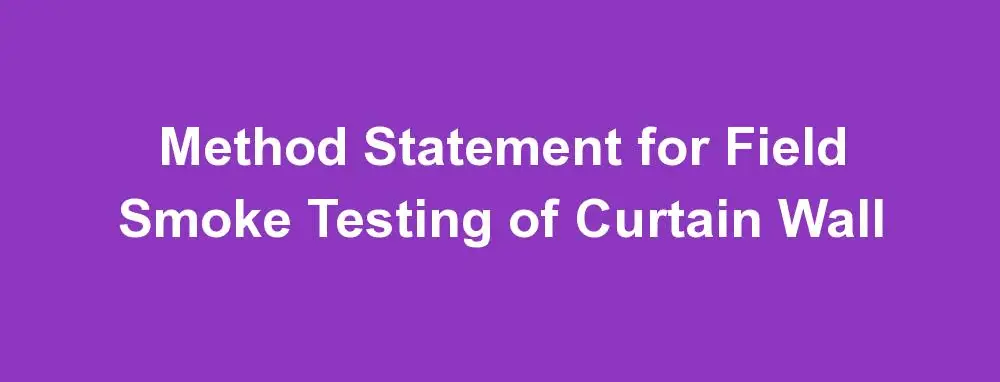The Method Statement for Field Smoke Testing of Curtain Wall describes the testing procedures, post-test analysis, report, testing equipment used, and other pertinent information covered in the methodology.
Once the system is finished and closed off, the aim is to ensure that there is no air leakage (and no humidity) entering the curtain wall system through serviced penetrations.
The testing apparatus comprises a hand-held smoke generator and a calibrated fan that is sealed to the unit entrance.
As smoke is poured from inside the room onto the penetration specimen that has been previously chosen by the consultant, the fan provides a constant flow of pressure into the unit.
Table of Contents
Method Statement for Field Smoke Testing
The field smoke testing procedure
The testing method detailed here ensures that the applied sealant performs well as a consequence of a combination of fan pressurization and smoke testing.
On the day of the anticipated test, the laboratory will perform a final inspection of the chosen rooms to make sure there are no unexpected openings in the building envelope and that the site conditions are set up to maximize airflow.
Utilize a window, door, or vent opening to join the air-moving apparatus to the building envelope. To prevent any leakage, make sure the joints between the equipment and the building are sealed.
For this building test, Minneapolis Blower Series fans were used. The room’s front door is used as a plywood blanking panel, and the fans are mounted in pre-fitted aluminum frames.
The pressure difference between the test internal building envelope and the exterior was measured using a micro manometer that is integrated into the fan and has been calibrated.
Each room unit will pressurize and depressurize simultaneously.
The chamber will be positively pressured with air during pressurization, and smoke generators will be deployed from the interior on the service penetrations to look for any leaks outside the room.
While the smoke generator is being applied to the samara area from outside the room, air ex-filtration (air movement from the interior to outside) will cause a negative pressure difference during depressurization. Any potential leaks will be checked for during the depressurization process from inside the room.
When pressurizing, certain service penetrations must be inspected (and de-pressurization).
Until the parameter is reached, the test should run for 7–10 minutes (once positive and once negative).
If the test’s results show that the parameter is being satisfied, the test is considered successful.
If the test results indicate smoke leaking through the chosen service penetrations, the test is considered unsuccessful.
Any leaking evidence will be photographed and included in the report.
Important information for air tightness testing
A competent and qualified individual (or persons) familiar with the facility who can grant access to the essential regions of the building would be needed for the laboratory on-site. This individual would also be in charge of providing advice on any site-specific health and safety needs. The laboratory will always offer skilled test supervision.
The laboratory suggests using smoke (vapor) path analysis to further investigate and spot-check common air leaks if the fan pressurization test reveals them. Smoke detection systems in specific areas may need to be temporarily turned off during this process if fire suppression systems are in use at the time of the test.
Qualified building staff will oversee and conduct fire detection system shutdowns, and they will also notify the appropriate authorities as necessary. If emergency services or other authorities are called while the test is being conducted, the laboratory is not responsible for them.
Reports and data analysis
Field Smoke Test results for each room will be included in the report, along with any additional photographs that are necessary. The report will be submitted electronically in PDF digital format.
Instrumentation and test equipment
The necessary equipment is generally described in the paragraphs that follow. Any setup of equipment that follows the same principles and can carry out the test process within acceptable tolerances is allowed.
Fans, blowers, HVAC air movement parts, or blower door assemblies that can move air into and out of the conditioned area at the necessary flow rates (at both positive and negative pressurization) under a variety of test pressure differentials are all examples of air-moving equipment.
The system must maintain a set pressure and a steady airflow at each incremental pressure difference for the duration necessary to record airflow rate values. Within 10 meters of the suggested test fan positions, 220 V electrical power sources that are provided by the site are necessary.
A pressure-measuring instrument, such as a manometer or pressure indicator, is used to measure pressure variations with an accuracy of 2 Pa.
The device that measures airflow with an accuracy of 7% of the observed flow is known as an airflow measuring system. The airflow measuring device must have recently undergone calibration.
Handheld Smoke Tracer Machine: A portable smoke generator that produces harmless, non-respiratory smoke by heating and pumping a specially formulated fluid. Off-white is the hue of the smoke so that it may be seen clearly wherever it is applied.
Power requirement: 400 watts
12 volts of voltage.
1 second is needed for heating.
A 250 ml fluid tank is available.
10 ml of fluid is consumed each minute at the continuous output.
Battery-powered fog time: 150 × 5-sec bursts or 10 ml/minute at continuous flow.
Start button 0-10v analog control.
Micro-pressor for controlling temperature.
Dimensions are 22.3 x 10.0 x 21.0 cm (L * W * H).
Battery weight included: 5.6 kg.
tag: method statement for field smoke testing
